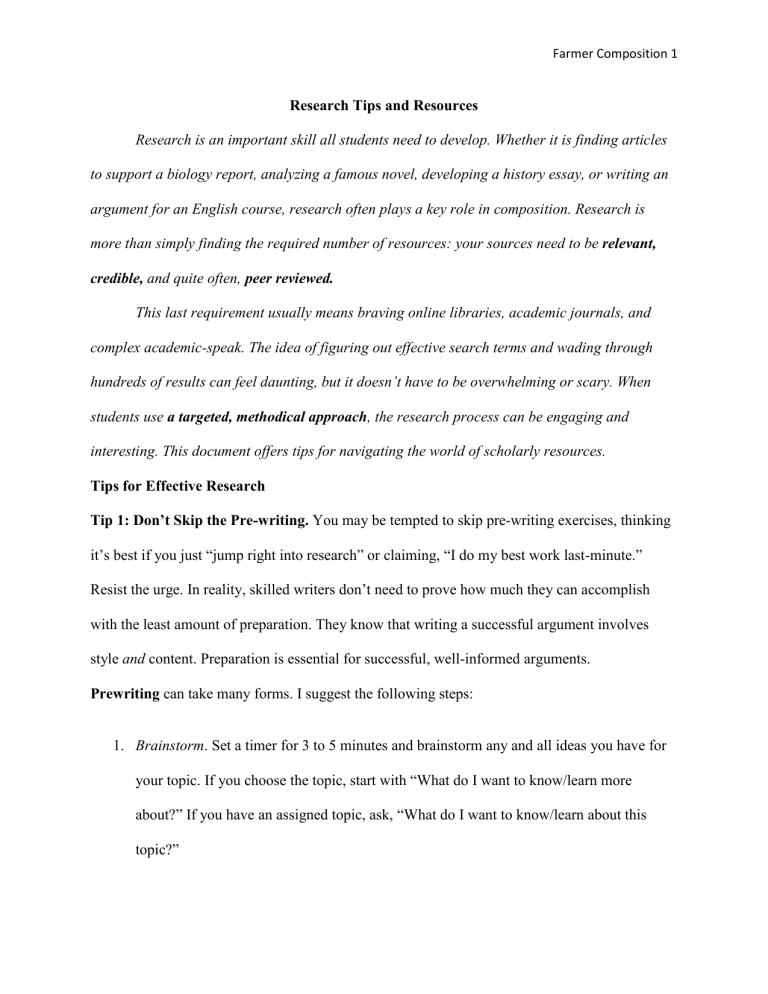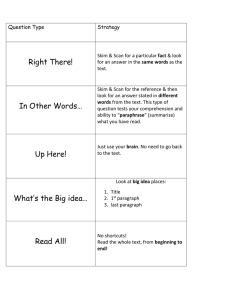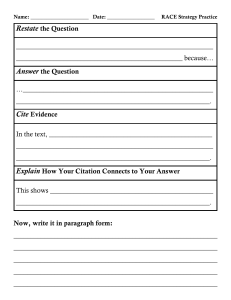
Farmer Composition 1 Research Tips and Resources Research is an important skill all students need to develop. Whether it is finding articles to support a biology report, analyzing a famous novel, developing a history essay, or writing an argument for an English course, research often plays a key role in composition. Research is more than simply finding the required number of resources: your sources need to be relevant, credible, and quite often, peer reviewed. This last requirement usually means braving online libraries, academic journals, and complex academic-speak. The idea of figuring out effective search terms and wading through hundreds of results can feel daunting, but it doesn’t have to be overwhelming or scary. When students use a targeted, methodical approach, the research process can be engaging and interesting. This document offers tips for navigating the world of scholarly resources. Tips for Effective Research Tip 1: Don’t Skip the Pre-writing. You may be tempted to skip pre-writing exercises, thinking it’s best if you just “jump right into research” or claiming, “I do my best work last-minute.” Resist the urge. In reality, skilled writers don’t need to prove how much they can accomplish with the least amount of preparation. They know that writing a successful argument involves style and content. Preparation is essential for successful, well-informed arguments. Prewriting can take many forms. I suggest the following steps: 1. Brainstorm. Set a timer for 3 to 5 minutes and brainstorm any and all ideas you have for your topic. If you choose the topic, start with “What do I want to know/learn more about?” If you have an assigned topic, ask, “What do I want to know/learn about this topic?” Farmer Composition 2 2. Narrow down your list. Circle the top 2 to 3 choices, based on the assignment requirements and your interests. 3. Create Clusters. Take one of your topics and narrow it down using the cluster method. You may need to create clusters for multiple topics before finding one that you want to explore. 4. Choose a Topic. This is the moment where you commit to exploring a topic and seeing where your initial research takes you. Note: Keep your clusters. You may change topics once or twice before committing to your research project. 5. Develop Research Questions. You don’t have a well-informed argument/thesis yet. First, you need to write down 5 research questions to help you explore different views and information on your topic. Tip 2: Create a Research Plan. Research is more than signing into your library database and plugging search terms into the main search box. Develop a plan for finding, evaluating, and organizing your research in advance. A few strategies include: 1. Using the online library tools to highlight, create notes, and save articles. 2. Dowloading/saving articles to a GoogleDrive, OneDrive account, or Flash Drive. 3. Taking notes via Word for each resource. 4. Copying MLA citations for each resource and saving in an app, such as Noodle Tools. 5. Using notecards to take notes by resource or topic. 6. Always recording page numbers or paragraph numbers for each quote/summary/fact you select from a resource. Farmer Composition 3 Tip 3: Develop a Research Strategy. You don’t have time to read through every search result that comes across your screen. Learn about the best ways to search, analyze, and skim articles before embarking on your research quest. Strategies include: 1. Use the CRAAP Test. This tried-and-true test will help you to quickly evaluate sources before committing to reading long articles. 2. Use Google Scholar. This resource offers excellent tips for navigating this popular search engine: https://www.editage.com/insights/8-winning-hacks-to-use-google-scholar-for-yourresearch-paper. 3. Annotate. Create an annotation key and/or strategy that you will use consistently throughout your research. Visit the website for detailed information on annotation strategies: http://www.hunter.cuny.edu/rwc/handouts/the-writing-process1/invention/Annotating-a-Text. 4. Use a Variety of Search Terms and Strategies. Do not rely solely on the search box at the top. Other strategies may include: a. Advanced Search b. Topic Search c. Subject Search d. Search a Specific Journal e. Follow Links f. Research Bibliographies/Works Cited of Useful Articles g. Follow the “Related Articles” Links h. Ask a Librarian for Help Farmer Composition 4 5. Narrow Down Your Options. Once you’ve found an effective search term and database, try selecting the following options: a. Peer Reviewed b. Full-Length Articles c. Edit out Book Reviews d. Select Specific Dates e. Choose “Newest” instead of “Most Relevant” 6. Strategically Skim the Article. Skimming an academic article involves more than simply reading a few lines. Follow these steps: 7. Review Diagrams. As you skim read through the article, you will have noticed that the text is interrupted by a set of diagrams. Diagrams, or figures, are usually intended to display an idea in a way that is easier to see and grasp than is possible with text. While skimming, look over any tables you encounter to see what kind of information they are displaying. If the information is relevant to your purpose, you can look at it more closely later. i. Read the title: titles typically reveal the main theory or variables being investigated in the article b. Read the abstract: the abstract will give you more information about the context of the theory and variable to see if it relates to your topic. This is the summary of the journal article. Almost all journal articles have an abstract. The abstract appears as a short paragraph at the start of the article, sometimes italicized or indented to set itself apart from the rest of the article. What's important: The Farmer Composition 5 abstract tells you the point of the article. Always read the abstract to make sure the article is suited toward your paper's topic. 8. Skim. Skim reading makes use of a normal convention for structuring writing: placing key information at the beginning of a “chunk” of text, then elaborating on that in the rest of that “chunk.” With this in mind, read only the first sentence of each paragraph to get the main ideas. If there are sections, read the first paragraph of each section. By knowing the point of each section, you'll find what you need quickly and without being bogged down by the convoluted language in these academic journal articles. 9. Treat critical reading as a skill to develop personal & academic responses. It can be developed through practices, such as: a. Marking and looking up all vocabulary and concepts that you are unfamiliar with b. Taking notes of the text's main ideas and adding your own responsive comments c. Talking to others about what you have read d. Relating a given text to others in the syllabus by identifying similar or contrasting themes e. Explaining what the text means to a non-specialist and noting what you would have to add to make it intelligible (This will help you to see the underlying, unstated assumptions.) f. Asking yourself: “How can I convince my peers/teachers that I understand what this is about?” 10. Academic articles, particularly research reports, generally contain the following: a. abstract b. introduction Farmer Composition 6 c. literature review d. methods e. data f. results 12. Read the Conclusion: The author's summary of the journal article. The author will also explain whether his or her thesis is correct, the implications, and what other research can be done. What's important: This section is vital. If you use this article as a source, you better know the general outcome of the author's research. It is a good idea to read this section after you read the abstract, then again after reading the rest of the article. Was it proven wrong? Right? Inconclusive? You can always turn to the results section if you can't find the answers you're looking for here. You may also find a suggestion for future research in the discussion of limitation that guides your own project. Questions to ask: a. Do you agree with the conclusions drawn from the data? b. Are these conclusions over-generalized or appropriately careful? c. Are there other factors that could have influenced, or accounted for, the results? d. What further experiments would you think of to continue the research or to answer remaining questions? 11. Bibliography/Works Cited: The bibliography is the list of sources the author has used. What's important: If you're in need of more sources, take a glance through the titles of this section. You may find articles you can use in your paper. 12. Final Advice: Farmer Composition 7 a. If you are reading articles for a research project, find a method of organizing your research that works for you. One way is to sort them by your purpose for reading. b. If you plan on using the information in any paper in any way, make sure your know proper APA citation (or other citation styles you are using) and gather all of the information from the article you need to do a full citation before letting it leave your possession, and if possible make note of how you can easily access the article again (what database you used, if it is in the library, if a professor owns a copy, etc.). c. Keep reading articles. The more articles you read, the easier it is to get useful information from them, and they become less of a chore to read.

